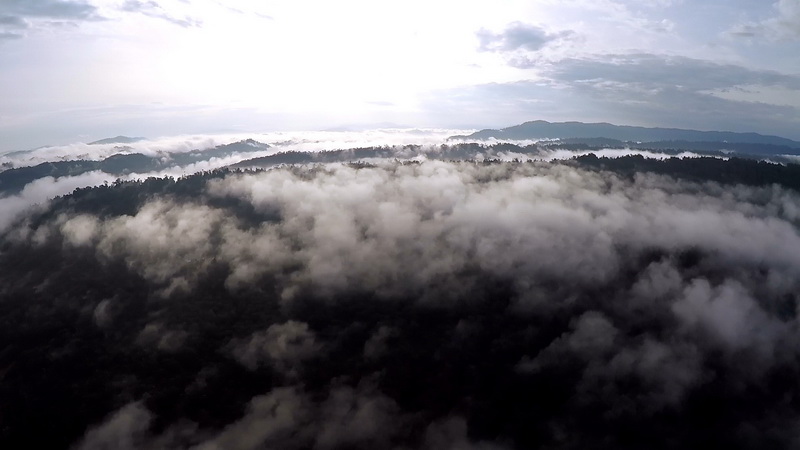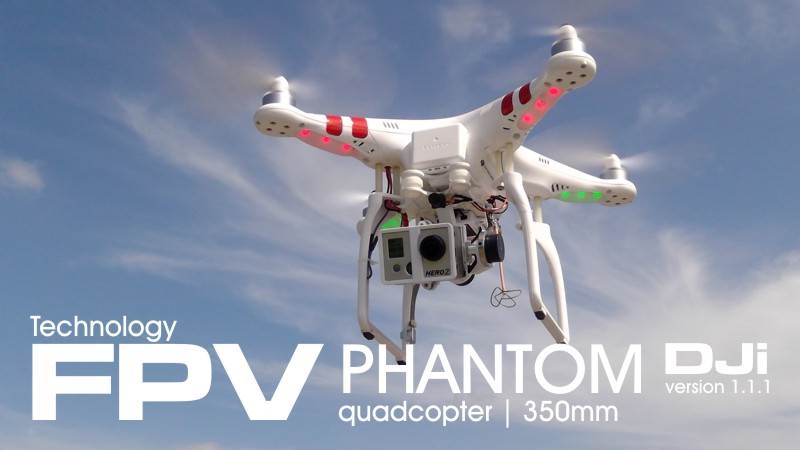
About
This is DJI PHANTOM V1.1.1 the last upgraded generation 1 and one step into FC40 version before PHANTOM V2. DJI PHANTOM lines of aerial flight gadgets are the most iconic and recognized flying tech around the world known for its direct accessibility to the public and creating lots of headlines both critics and controversial use after 2 years of its release. Made by DJI (Da-Jiang Innovations Science Technology Co., Ltd) and company in 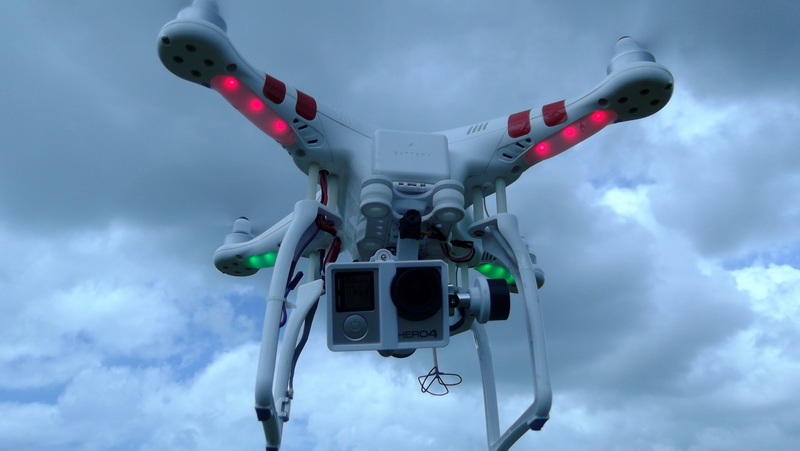 Shenzhen, Guangdong, China aim to facilitate aerial videography and photography task to both commoner and professional user. Today its widely use as most successful aerial platform for both amateur and commercial multimedia producer to produce aerial video for home entertainment and digital video content online. Google around the internet keywords "DJI PHANTOM" is a no brainer, lots of article, cool videos, fascinating aerial imagery, news headlines and incidents which make it famous and yet drawing a lot of "drone" controversy for it uses due to its capability to carry out aerial task which almost as capable as real UAV drone mimic industrial and military grade capability such as semi autonomous, waypoint flight and autopilot (Return To Home). Its internally advance hardware/electronics system allow excellent flight stability that allow un-experienced or anyone who doesn't know how to fly a model to be able to fly with just basic stick movement on the controller in just minutes after out of the box. On online market and local store it can be fetched around USD$299~USD$550 depending what accessories and features included in the package. By the end of 2014 it has sold millions all over the world and consider the number one in leading consumer drone in the market which its selling point was "everyone can fly".
Shenzhen, Guangdong, China aim to facilitate aerial videography and photography task to both commoner and professional user. Today its widely use as most successful aerial platform for both amateur and commercial multimedia producer to produce aerial video for home entertainment and digital video content online. Google around the internet keywords "DJI PHANTOM" is a no brainer, lots of article, cool videos, fascinating aerial imagery, news headlines and incidents which make it famous and yet drawing a lot of "drone" controversy for it uses due to its capability to carry out aerial task which almost as capable as real UAV drone mimic industrial and military grade capability such as semi autonomous, waypoint flight and autopilot (Return To Home). Its internally advance hardware/electronics system allow excellent flight stability that allow un-experienced or anyone who doesn't know how to fly a model to be able to fly with just basic stick movement on the controller in just minutes after out of the box. On online market and local store it can be fetched around USD$299~USD$550 depending what accessories and features included in the package. By the end of 2014 it has sold millions all over the world and consider the number one in leading consumer drone in the market which its selling point was "everyone can fly".
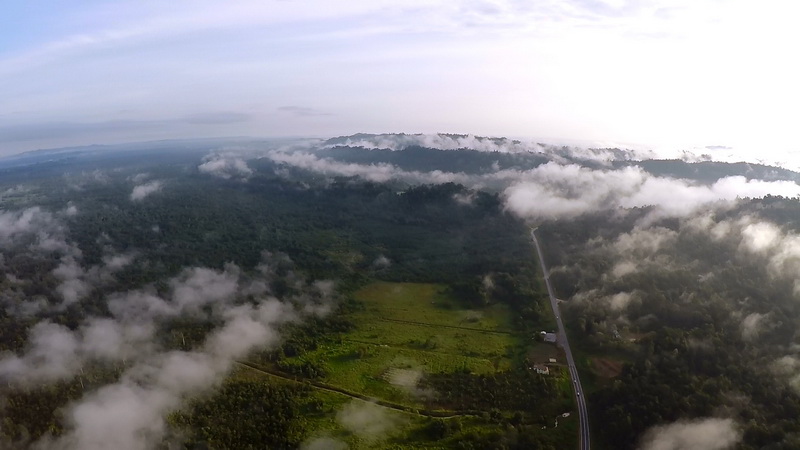
So what's up with me buying a DJI Phantom V1 if i already know how to build my own flying multi-rotor platform and bunch of other stuff better than this? Number 1: it is because building multi-rotor will take days, week and month to accomplish a perfect functional flight...i don't have much time to build a new ones, time consuming stuff doesn't fit my mid age crisis..i'm getting old for this. Best word to describe this phantom is just one word: "CONVINIENT". Ok the reason i buy even though i have other platform that perform better than PHANTOM because of several factor as mention below:
-
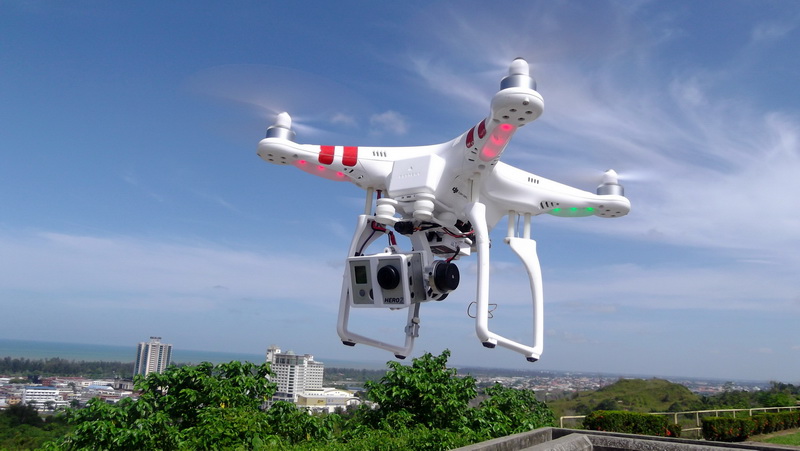 STABILITY
STABILITY
100% stability assist flight, beginners can fly 100% guarantee. You don't need skill to fly. -
PERFECTION
Manufacturer design it as convenient as possible not only in-terms of flying but also maintenance and upgrade ability. When you take off at "that spot" it will return home automatically at "that spot" with minimal error. A screw driver and an Allen key is all you need to add-on upgrades. Just plug your upgrades and fly. -
VIDEO/AERIAL PHOTOGRAPHY
This is where PHANTOM shines the most among all multi-rotor/drone platform in the market. Less vibration flying platform and adaptable with any popular camera installation in the market such as GO-PRO, SONY, SJCAM, WALKERA iLOOK and other compact digital and sports camera in the market. -
LESS MAINTENANCE + MORE SUPPORT
It has clean design, full encapsulated electronics, use simply by hand to remove t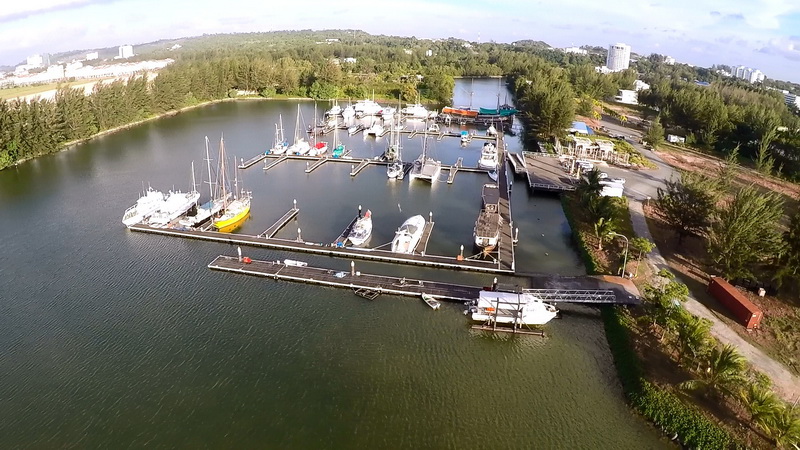 he proppeller without tools, plug-in to install add-on and it has huge community based support for PHANTOM products both official and unofficial forum/discussion groups to save your time searching for resources. Manufacturer constantly provide firmware updates for both old and new models to improve their products to their customer. USB connectivity for easy software base tuning.
he proppeller without tools, plug-in to install add-on and it has huge community based support for PHANTOM products both official and unofficial forum/discussion groups to save your time searching for resources. Manufacturer constantly provide firmware updates for both old and new models to improve their products to their customer. USB connectivity for easy software base tuning. -
PORTABILITY + TRAVELLING
It is smaller compare to my 450 size multirotor. No wires dangling around because all electronic components are fully encapsulated inside plastic housing. Every parts such as gimbal and propeller can be easily remove by hand and easily fit side normal size travelling boxes. No matter which country you go there are always DJI PHANTOM parts available nearby if you need urgently.
The PHANTOM V1.1.1 model is just a step into PHANTOM FC40 without extra gimmick. It inherit several improve feature such NAZA V2 flight controller, self locking propeller, improve motor, receiver with diversity 2.4ghz antenna unlike the early release of PHANTOM V1.0. Bone stock this is a perfect version for me because it has all the basic requirement for conversion into FPV multi-rotor platform without dragging unnecessary hardware or gimmick that burns your budget. For V1.1.1 at USD$250 is a great deal. PHANTOM V2 will cost double at $499 min average startup basic model. The rest of my budget will be invested into hand picked performance aerial videography hardware such as G-2D Walkera gimbal, Go-Pro HERO 4 BLACK, 520TVL nano CMOS camera for FPV viewing, external BEC, 5.8ghz 200mw video transmitter, DJI PMU-V2 power module for extra CAN-BUS port and DJI OSD mini for screen HUD layout.
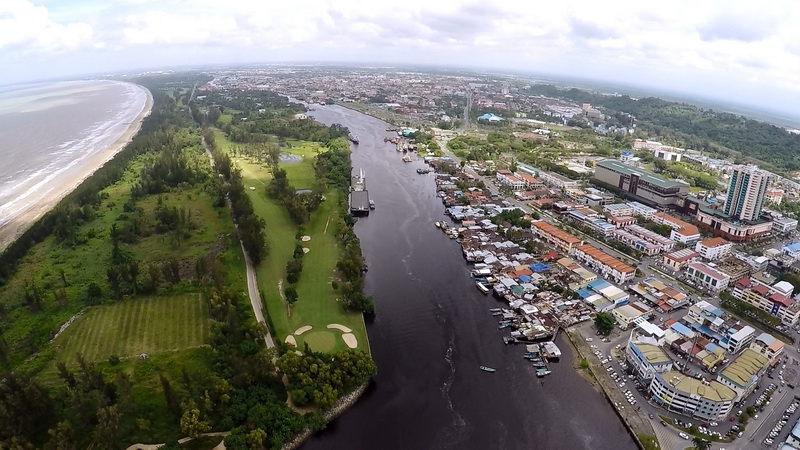
Model specification & setup
Phantom q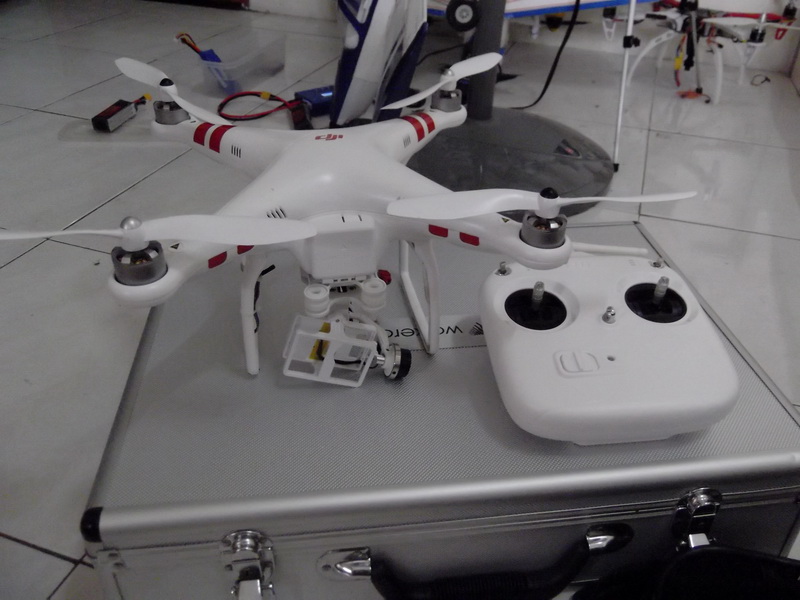 uadcopter:
uadcopter:
Airframe type: multirotor - quadcopter
Branding/Manufacturer: DJI, Hobby King, cloned
Model name variant: PHANTOM V1.1.1
Material build: Plastic
Rotor to rotor: 350mm
Width: 350m
Height: 190mm
Stock weight: 700~gram
Flight control board: NAZA-M V2.
ESC: Stock
Motor: Stock
Proppeller: Stock
Radio receiver: DJI@FUTABA bind-able
Radio receiver antenna: Diversified 2x di-pole
Battery: 2200~2700mah 3s 35c~45c
Power consumption: 3.12W
Radio:
Working frequency: 2.4ghz ISM
Control channels: 7ch
Radio range/distance: 800~1000m
Receiver sensitivity (1%PER): >-100dBm
Transmitter power consumption: <20dBm
Working current/Voltage: 52mA@6v (4x 1.5 AA battery)
My DIY FPV specification with aerial 4k HD video/photography spec
Below are list of hardware needed to upgrade to FPV specification:
- Camera: 520TVL nano CMOS 90 degree lens running at 3.3v
- * Optional - Secondary camera: GO-PRO HERO 4 BLACK (4K HD)
- * Optional Camera brushless gimbal mechanism: G-2D WALKERA gimbal (white)
- OSD: DJI iOSD mini module (setup wiki)
- Power module for extra CAN-BUS support: DJI PMU-V2
- External BEC to power 520TVL main camera: HK mini 3A/3V UBEC (required to setup down low powered camera).
- Video transmitter: 5.8ghz 200mw Boscam video transmitter
- Video antenna: DIY tuned CL antenna
- Battery: Shared with main.

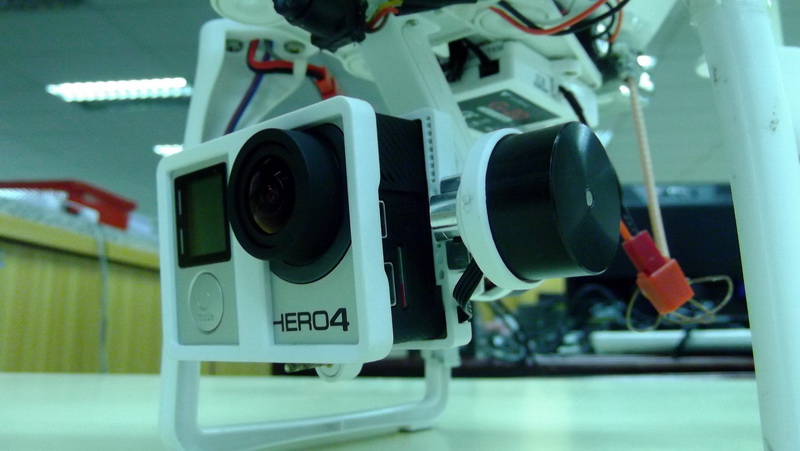 |
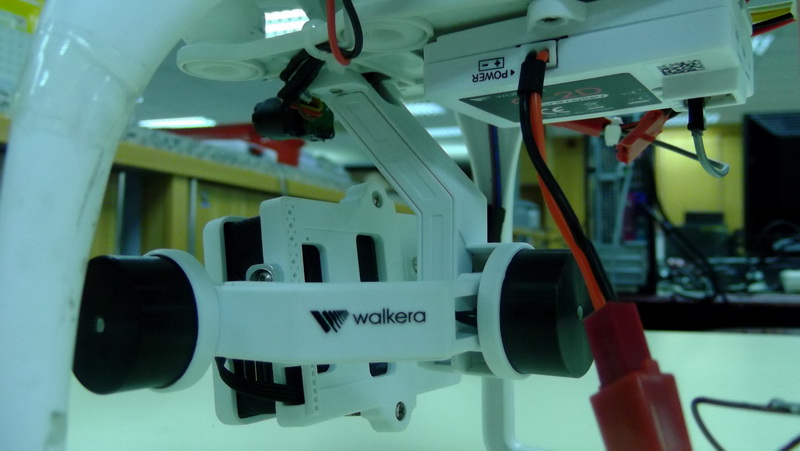 |
Building
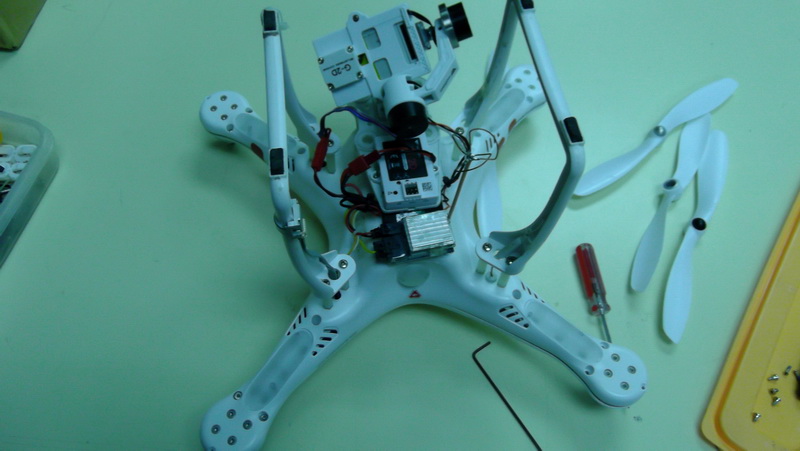 Its not difficult to install FPV hardware into this little bug. Just remove all that not necessary needed to keep overall "super lightweight", keep the wires short and thin and solder with little blob to the connection. The FPV hardware are extremely basic: just a nano camera and nano size video transmitter (1.2/2.4/5.8ghz) powered from separate single micro lipo pack 150mah 1s. A good build will give you a perfect total flying weight of below 70 gram. If you're planing to do some aerial video/photography a totally naked/stripped 808 #16 V2 HD key-chain can be stick under the belly with total flying weight of 83 gram. You'll need to be creative to custom made a soft landing gear to handle rough landing. Some thin looped zip ties under the gear cage will do the job to spring dampen any harsh landings.
Its not difficult to install FPV hardware into this little bug. Just remove all that not necessary needed to keep overall "super lightweight", keep the wires short and thin and solder with little blob to the connection. The FPV hardware are extremely basic: just a nano camera and nano size video transmitter (1.2/2.4/5.8ghz) powered from separate single micro lipo pack 150mah 1s. A good build will give you a perfect total flying weight of below 70 gram. If you're planing to do some aerial video/photography a totally naked/stripped 808 #16 V2 HD key-chain can be stick under the belly with total flying weight of 83 gram. You'll need to be creative to custom made a soft landing gear to handle rough landing. Some thin looped zip ties under the gear cage will do the job to spring dampen any harsh landings.
FPV building level difficulty/rating: Medium (7/10)
FPV equipment setup grade: Basic
Building hours required: 5 hours
Skill required: Soldering
Critical issues during installation: Beware loose connector on OSD mini and wire coloring.
Required additional mods/must do improvement: Hot glue battery wiring plug junction
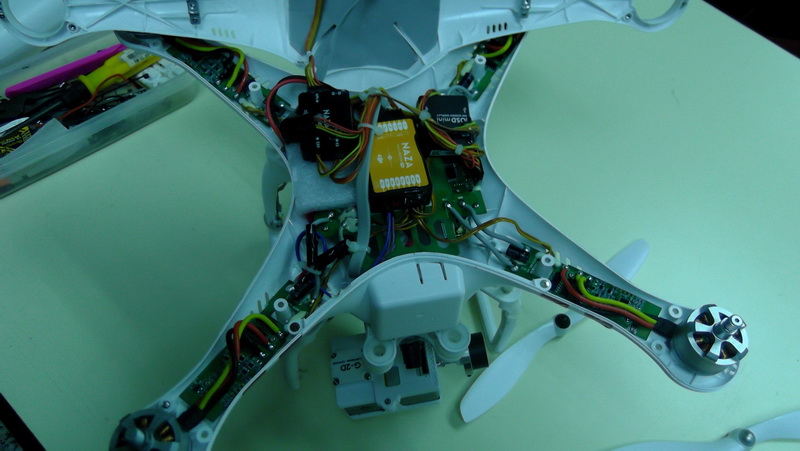 |
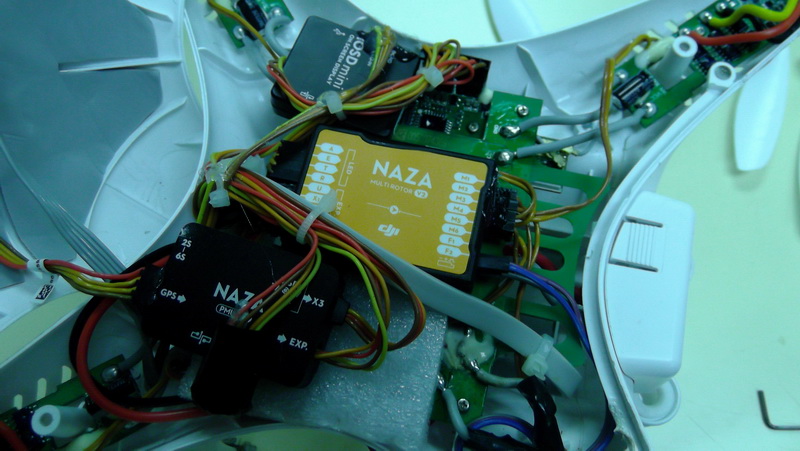 |
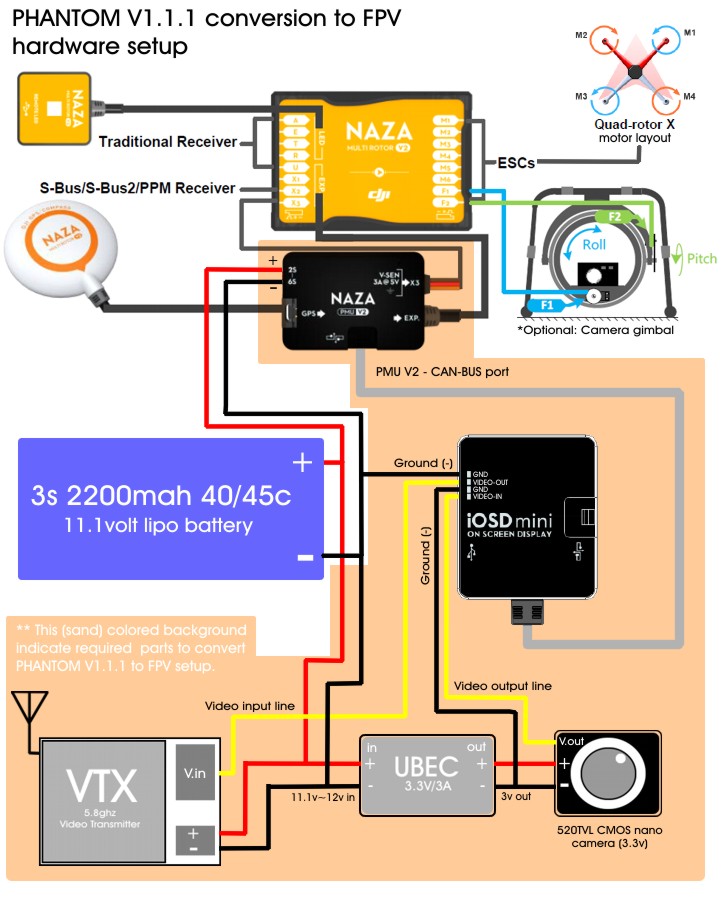
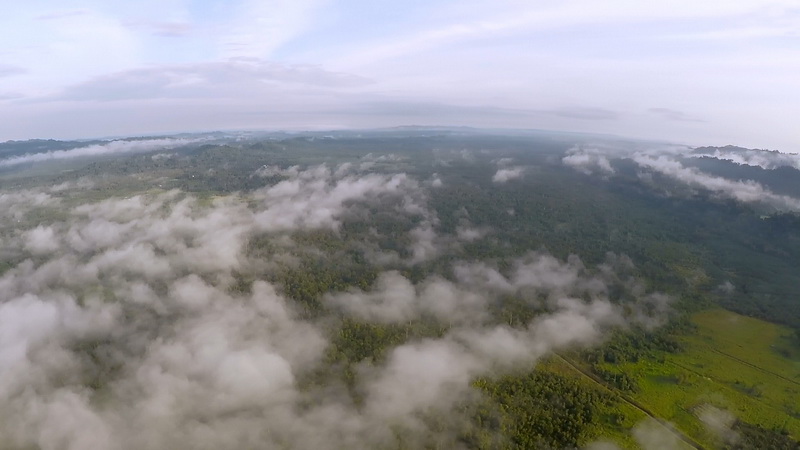
FPV flight characteristic and performance
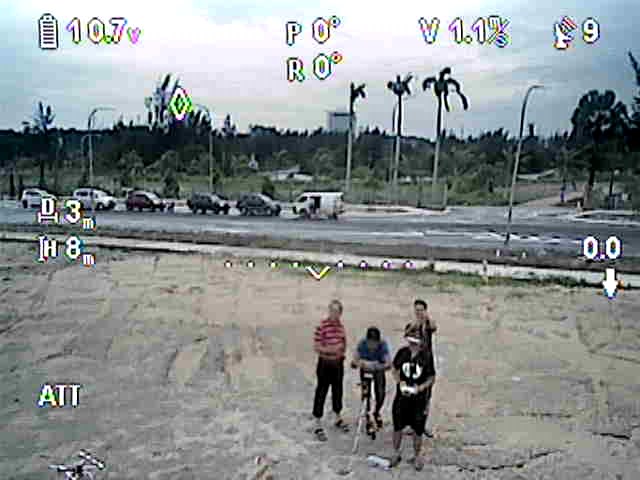 Flying a PHANTOM is far easier than anything I've flown before which is why its is most popular among starter/beginner flyer. All i just need to do is push the throttle to hover certain altitude and move around just like R/C toy car. If you're in panic mode hit the Fail safe switch and it will return back to home automatically to where you started. After flying around for weeks i got bored easily and wasn't much fun for me because the control are rock solid stable and restrictive especially when there's a heavy wind. Its very hard to do aerobatic flight or aggressive fast maneuver because its nature meant to do aerial video/photography makes the flight straight linear line. All those kamikaze dive, fast roll/banking and thing like you do in plane are very impossible on Phantom unless some PID stabilization are changed manually via NAZA-M flight assistant software. For example if i'm low on battery on high altitude usually i'll tilt my quadcopter/multi-rotor nose down angle of attack and dive down like a plane so it drop down like gliding like a plane to reach low altitude so i could hover quickly and return to ground before battery LVC kicks in. But for stock PHANTOM its very hard to do that, so if your battery is dangerously low a high latitude lets say 400m it you'll need to lower the throttle and it will hover "slowly" down vertically straight like UFO. You can't slow the throttle too much else it will
Flying a PHANTOM is far easier than anything I've flown before which is why its is most popular among starter/beginner flyer. All i just need to do is push the throttle to hover certain altitude and move around just like R/C toy car. If you're in panic mode hit the Fail safe switch and it will return back to home automatically to where you started. After flying around for weeks i got bored easily and wasn't much fun for me because the control are rock solid stable and restrictive especially when there's a heavy wind. Its very hard to do aerobatic flight or aggressive fast maneuver because its nature meant to do aerial video/photography makes the flight straight linear line. All those kamikaze dive, fast roll/banking and thing like you do in plane are very impossible on Phantom unless some PID stabilization are changed manually via NAZA-M flight assistant software. For example if i'm low on battery on high altitude usually i'll tilt my quadcopter/multi-rotor nose down angle of attack and dive down like a plane so it drop down like gliding like a plane to reach low altitude so i could hover quickly and return to ground before battery LVC kicks in. But for stock PHANTOM its very hard to do that, so if your battery is dangerously low a high latitude lets say 400m it you'll need to lower the throttle and it will hover "slowly" down vertically straight like UFO. You can't slow the throttle too much else it will 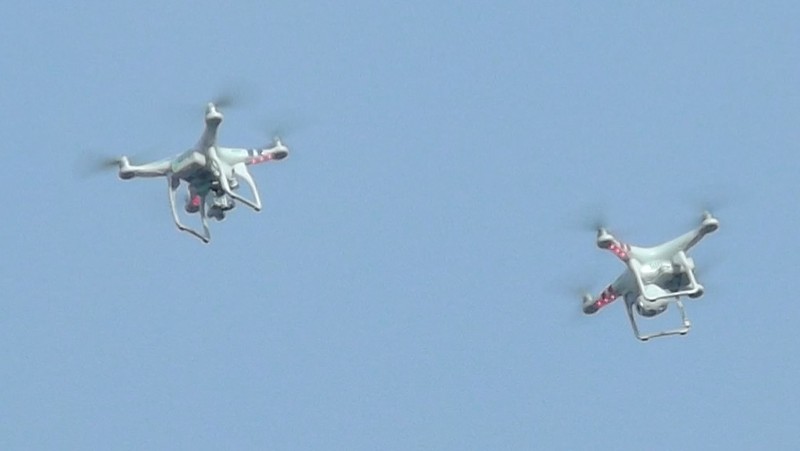 cut-off or stall badly into toilet bowl crash. For any experience FPV multi-rotor pilot who used to fly and zig zag around tree or racing with buddies through obstacles acrobatically they will realized PHANTOM movement are extremely restrictive as if you're flying on a disabled wheel chair. So long range FPV isn't a good idea on these platform unless its loaded with high capacity battery for longer flight time just enough time to recover from possible error or mistake. So best left the PHANTOM as what it is as aerial video and photography gadget.
cut-off or stall badly into toilet bowl crash. For any experience FPV multi-rotor pilot who used to fly and zig zag around tree or racing with buddies through obstacles acrobatically they will realized PHANTOM movement are extremely restrictive as if you're flying on a disabled wheel chair. So long range FPV isn't a good idea on these platform unless its loaded with high capacity battery for longer flight time just enough time to recover from possible error or mistake. So best left the PHANTOM as what it is as aerial video and photography gadget.
So if you're buying a PHANTOM just to think you can learn and improve your flying skills? Turn around and move on....you're not going anywhere with that. Real flying is far apart from what PHANTOM have to offer nor its a shortcut to a better skills. Controlling wise on PHANTOM traditionally its all wrong, (1) The throttle stick is in the middle which is non-standard in R/C world. Stop hover move stop hover move stop hover move thing won't teach anything worth flying. (2) Flies like a UFO, go vertical up, move left right up down and that's it, lack of feeling of real flight experience such as roll, stall, turbulence and counter movement. PHANTOM have too much electronic tech assisted flight. If the GPS locks are gone where user depends on it then trouble will looms.....then you'll have "Fly-away" incident coming on you.
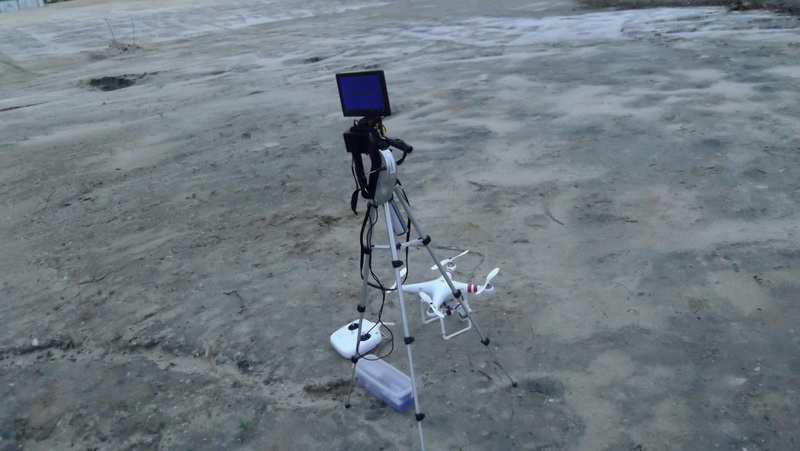 Minimum level of flight experience required/flight-hours: Beginner(3 hour)
Minimum level of flight experience required/flight-hours: Beginner(3 hour)
Nature of platform handling experience/skill required: Beginner
Self leveling capability in thumbs-off stick situation: Yes (Stabilized mode)
Take-off & landing difficulty: Easy
Take-off weight: <1200g
Hand launch: No
Max flight velocity: 10m/s (still testing)
Max ascent/descent speed: 6m/s
Max tilt angle: 45 degree
Max altitude (manufacturer default): 2000m
Bail-out/fail safe recovery altitude limit: -
FPV flight/radius: 500m ~ 800m max (given above FPV spec/setup)
FPV safe distance range for testing: 300~800m (Open field)
Hovering Accuracy (GPS Mode): Vertical=0.8m + Horizontal=2.5m
Flight time: 7~11 min
Ground spotter visibility (LOS): 250~300m
Safety issue
A fully loaded aerial video/photography grade PHANTOM is extremely heavy than my slightly bigger APM Q450 size home custom build multi-rotor. Added main FPV camera for piloting ,secondary GO-PRO camera for HD recording, 2-axis camera gimbals, PMU-V2 module for extra CAN-BUS port, OSD mini and video transmitter as flight necessity for FPV requirement accumulate around 1.2kg of full flying weight which last me between 9~11 minutes at 10.3v Low Voltage Cut off (LVC) which i set manually as first stage LVC (voltage sag = 0.6v). Others issue are mentioned below under "CONS" section:
Pros and Cons
Here are list of pros and cons about this platform. Some of this are needed to take seriously if you are going deep into long term FPV ambition on PHANTOM.
Pros:
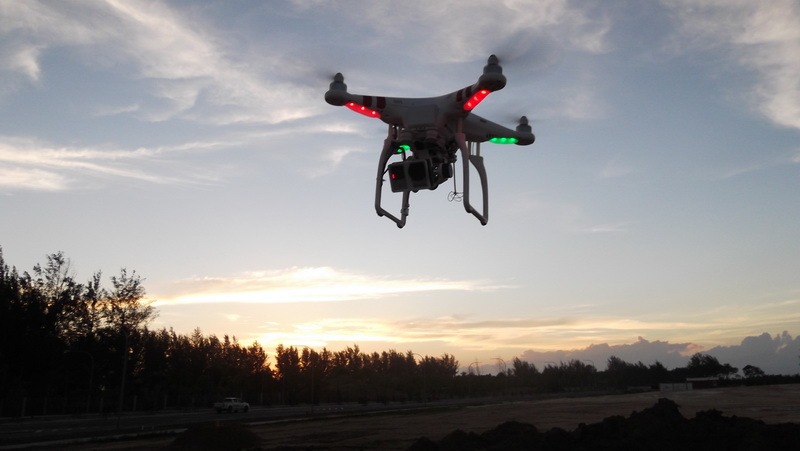 Out of the box the PHANTOM requires less tuning and minimal vibration problem from rotor spin which make less vibration during aerial video/photography. Where as my Q450 and other custom build multi-rotor requires constant rotor and propeller balancing to reduce vibration which consume time and money.
Out of the box the PHANTOM requires less tuning and minimal vibration problem from rotor spin which make less vibration during aerial video/photography. Where as my Q450 and other custom build multi-rotor requires constant rotor and propeller balancing to reduce vibration which consume time and money.- Precision altitude holding and GPS driven flight. OK i have to admit when compare against all my GPS driven platform such as ARDUPILOT-APM, G-OSD, Multi-Wii and WALKERA module the PHANTOM driven on NAZA V2 GPS system perform perfect precision flight both on take off, altitude holding and return home to landing at the same exact spot with less than
- Adding extra DJI hardware module is as easy as plug-in wiring with no soldering needed.
- Lots of local vendor spare parts and online community support.
Cons:
- Require constant compass calibration when flying in different places due to local geo-magnetic attributes in local area so before flight compass calibration is compulsory to avoid "run-away" issues which contribute 40% of lost control during GPS driven Return to Home activation due to compass navigation error.
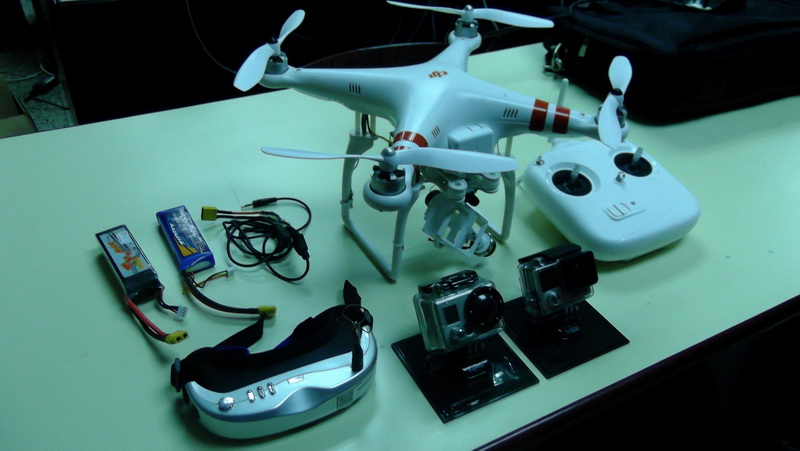 Stock radio have shorter range compare to standard hobby grade radio system. With Go-Pro Hero 4 camera (Internal WIFI turned off) mounted the radio range seems to be randomly short range cut between 150m~500m.
Stock radio have shorter range compare to standard hobby grade radio system. With Go-Pro Hero 4 camera (Internal WIFI turned off) mounted the radio range seems to be randomly short range cut between 150m~500m. - "Geo-fencing" issues. Especially on latest PHANTOM V2 all latest firmware updates include GPS feature where if the model fly into grey zone where intersect with civilian/commercial flying zone near airport around 5~10km perimeter/radious the PHANTOM will abort flight and return home immediately disabling any flight until the user start to take off fly far away from the critical zone. Happens if the firmware updates include "Geo-fencing" so watchout for that.
- Spare parts are very expensive. Hey! DJI is a luxury brand. You're buying a LEXUS of drones.
- Random problem with "Fly-away" issues. It happens when there a drop in satellite lock, radio wifi interference or compass malfunction causing the PHANTOM to drift away from user control and has its own mind flying off from the user. This has been countered and reported a lot all over the web including proof of video posted on youtube. So far till today at the time of writing there are no proper solution nor the manufacturer itself able to troubleshoot the problem but assume in theory it might be user piloting error, calibration problem, wifi interference, lost GPS and other factor which not proven 100% sure. Support on this issues fail to address by the manufacturer leaving consumer who lost their PHANTOM at emotionally distress and confusing. Lots of PHANTOM user started to post frustration and also started PHANTOM "Fly-away" trauma center in social media such as in FACEBOOK. So whenever i fly i always get this awry feeling that it could flew off anytime having it own mind without my control. Visit https://www.facebook.com/djiflyaway
Current status & flight history
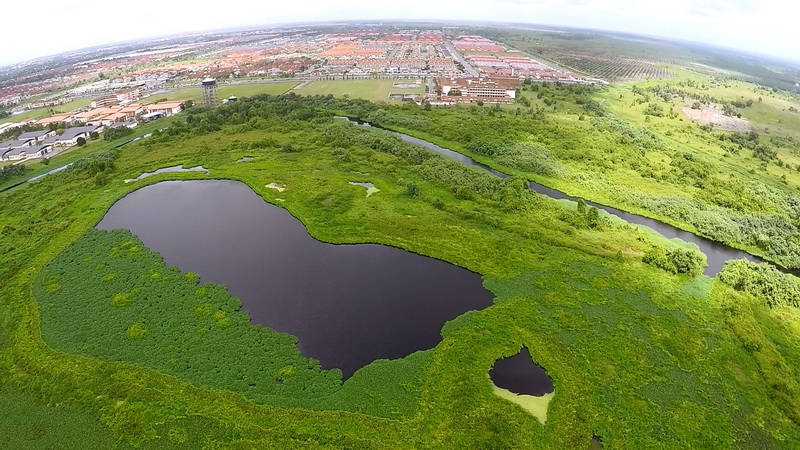 After converting my DJI PHANTOM V1.1.1 into full fledge FPV flight setup i only flew short distance only unlike other previous model i built for long range. Its the only platform that has it role just to do aerial video and photography which requires me to do some cool shots from various places travelling spot. Going long range beyond 1km (1000m) is not my idea i had in mind, for the year 2015 i'm investing more into video and photography project to create stunning photography with rich color, sharp quality, 4K HD and something very environmentally beautiful for me to enjoy and life aspiring beauty around me. So there not much of a drone patrol task, its more of a tool of paint brush and watercolor for my blank canvas. However it is consider most expensive investment i put on PHANTOM at least USD$1,770 compare to my average USD$250 on my FPV/UAV planes and custom multi-rotor before it, so i really need to put my PHANTOM to a good meaningful use to break even the costing.
After converting my DJI PHANTOM V1.1.1 into full fledge FPV flight setup i only flew short distance only unlike other previous model i built for long range. Its the only platform that has it role just to do aerial video and photography which requires me to do some cool shots from various places travelling spot. Going long range beyond 1km (1000m) is not my idea i had in mind, for the year 2015 i'm investing more into video and photography project to create stunning photography with rich color, sharp quality, 4K HD and something very environmentally beautiful for me to enjoy and life aspiring beauty around me. So there not much of a drone patrol task, its more of a tool of paint brush and watercolor for my blank canvas. However it is consider most expensive investment i put on PHANTOM at least USD$1,770 compare to my average USD$250 on my FPV/UAV planes and custom multi-rotor before it, so i really need to put my PHANTOM to a good meaningful use to break even the costing.
Lifespan operation: 4.5 months (by 19 June 2015)
Maintenance priority check: Battery connector soldering junction (wire will frayed/cut after multiple battery insertion)
Constant critical issue: Short range on stock radio (cut out and auto RTH randomly between 150~800m with Go-Pro mounted)
Maintenance cost per-lifespan: None
Flight hours accumulated per-lifespan: 211 hours (by 19 June 2015)
Best L.O.S distance record: 800~950m
Est. distance covered per-lifespan: 2,362km (Odo) (by 19 June 2015)
Best height record: -
Best flight time record per-session: 11min (2200mah 3s 40c)
Activity status: Active for aerial video/photography task
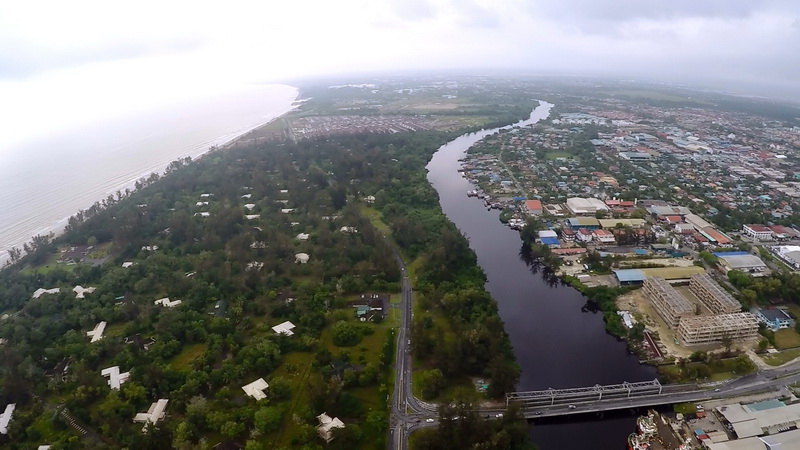
Pre-flight to do list before maiden flight
Here are 'must' to do list before you intend to do some serious flight that is not mentioned in the manual other than normal calibration procedure, check some list to do below:
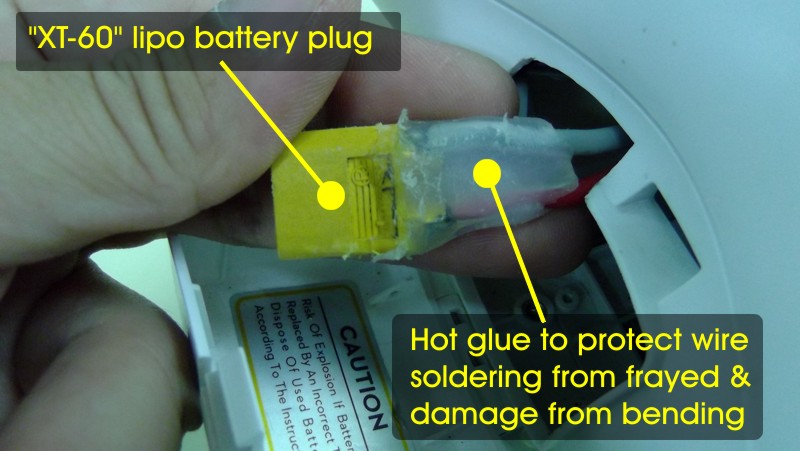 Reinforce wiring on the battery plug (XT-60/Dean plus soldering junction).
Reinforce wiring on the battery plug (XT-60/Dean plus soldering junction).
On PHANTOM V1 and FC40 models both uses either XT60 or Dean connector to plug into 3s 2200mah~2700mah lipo battery. However after high frequency usage of plug unplug and insertion action into the battery compartment the wire soldering junction on connector will frayed in very short time period and will cause low current flowing into the board and finally disconnected/cut which causes serious crashes. I highly recommended you reinforce the around the soldering section with hot glue to reinforce and reduce wire bending around it. If you bought a second hand PHANTOM then you must remove the heat shrink around the wiring to check the soldering junction around the plug since the previous owner may use it multiple times. 90% the soldering may break or wire may frayed so if you do spot the defect you should resolder and apply some hot glue around it for accident prevention.- Enlarge wiring bay for PHANTOM V1.
As shown in the picture you may need to chip off some plastic around the wiring and cable insertion at the battery cover opening to avoid the wire being squashed and clipped. Enlarging it will allow you to slide the battery wire and pull the battery much easily.
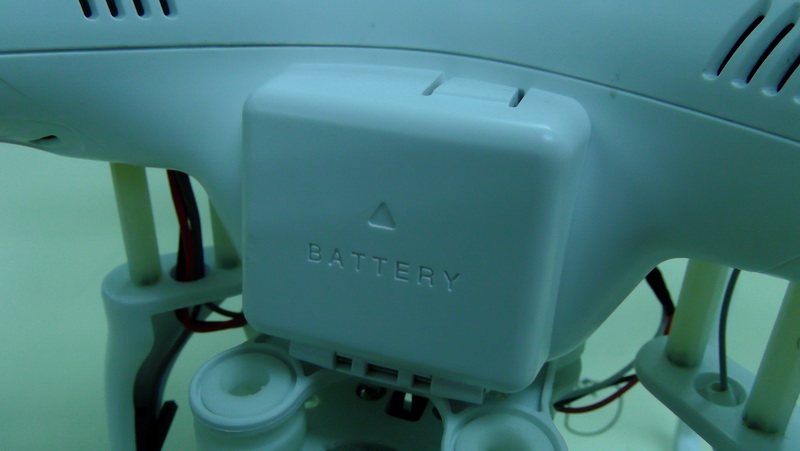
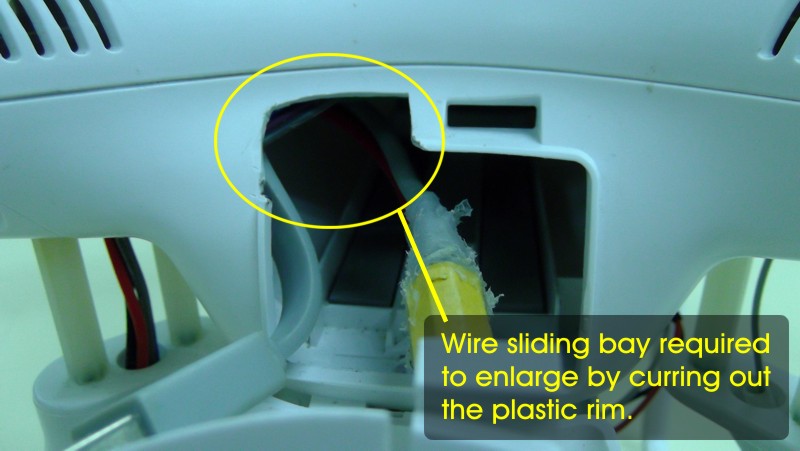
- Set Fail Safe switch on S1 switch.
By default the controller S1 switch at right shoulder have 3 position mode: lowest =ATTI, middle=ATTI and top=GPS holding. Go to the NAZA Assistant software to enable FAIL SAFE switch at the bottom of the switch position you will have extra option to activate automatic Return To Home and Landing without having to switch of your controller to do that.
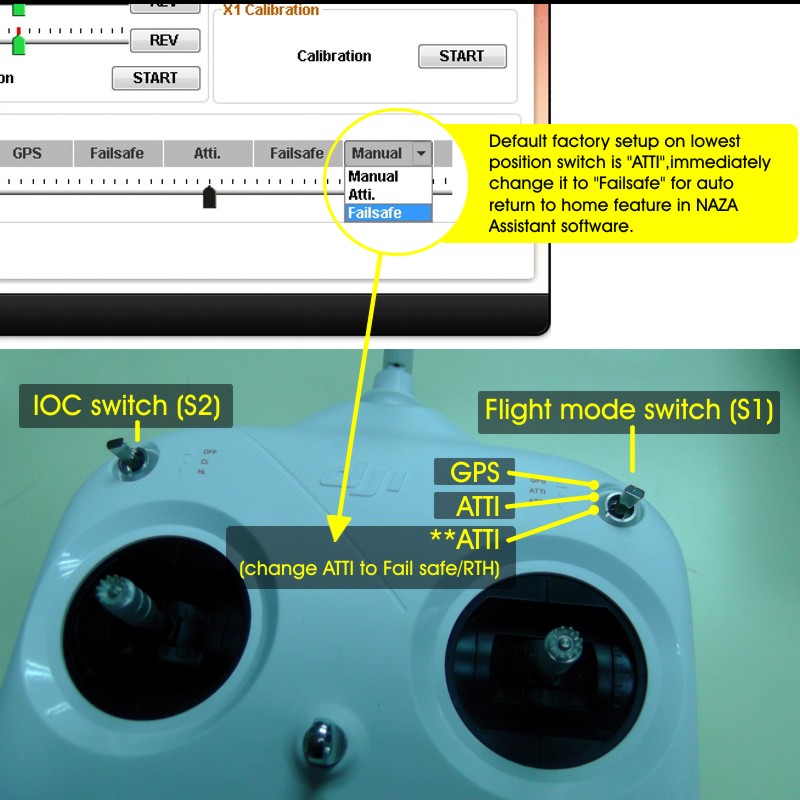
- Turn off IOC S2 switch (Intelligent Orientation Control)
Many of reported crashes are due to IOC enabled. IOC switch is located on the left shoulder side of the controller. IOC provide headless flight mode usually useful for aerial video/photography when flying and capture video/photo shots sideways....useful for person who is unskilled or dumb at flying. Sometimes confusion might happens because of flight mis-orientation or wrong flight headings when IOC is switched around more often but quite useful for recovery by pushing the elevator backwards to to bring the quad towards you. Turn the IOC off via NAZA assistant software if you don't need it and make sure S1 low position switch enabled Fail Safe option to activate return home after IOC disabled.
Caution lists
Here are also list you need to be caution when you go about putting upgrades, during flight or any mods deem to be disasterious. So check the list below to see what kind of hazardous problem will happen if you did one of these:
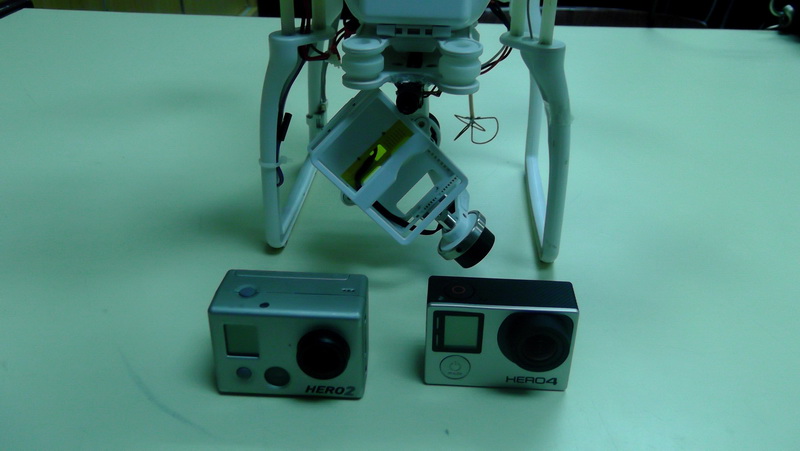 GO-PRO or Sport camera (WIFI operated) on PHANTOM.
GO-PRO or Sport camera (WIFI operated) on PHANTOM.
I did some camera test both on Go Pro HERO 2 and HERO 4. I notice the range was cut short by half the original distance on HERO 4 even the WIFI camera was turned off after around 5~6 minutes in the air. The PHANTOM receiver module dual diversity antenna located on both legs when on Line Of Sight signal was blocked by placement of HERO 4 camera. HERO 4 will get overheated really quick when recording at high frame-rate above 60fps ranging especially at 2.7K~4K resolution, probably the thermal give some interference? I just don't know but however the old HERO 2 doesn't have issues at old except it was slightly overweight and less sharp in resolution when compare to HERO 4.- Avoid touching compass while calibration.
The compass module usually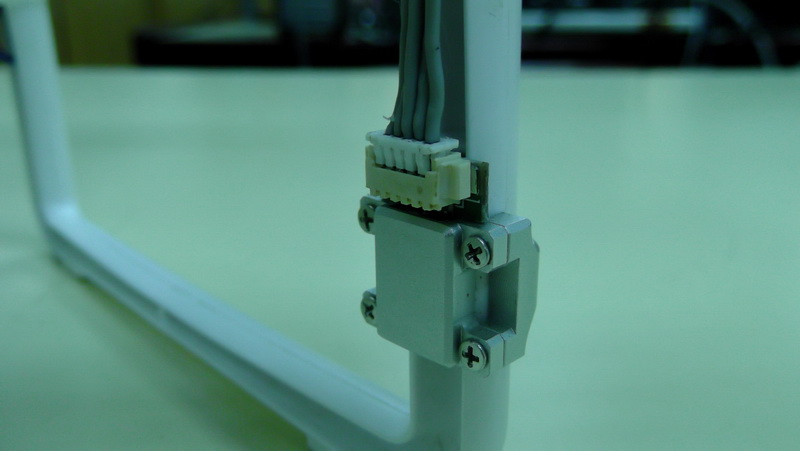 located at the bottom of PHANTOM body tied to one of its leg close to the ground. The reason why manufacture do that externally is to isolate magnetic interference inside the quad from flight controller electronic boards, motor and anything driven byn magnetic/electric. The problem arise during calibration where user tends to hold both legs by hand and spin around the quad during compas calibration procedure not noticing that the actually have their palms grasp around the compass where the leg is. Our hand still hold static electricity from as we leave from the car, holding metal car door, fabric seat and etc without first grounding it. So when holding the PHANTOM be sure to steer away from touching the compass module.
located at the bottom of PHANTOM body tied to one of its leg close to the ground. The reason why manufacture do that externally is to isolate magnetic interference inside the quad from flight controller electronic boards, motor and anything driven byn magnetic/electric. The problem arise during calibration where user tends to hold both legs by hand and spin around the quad during compas calibration procedure not noticing that the actually have their palms grasp around the compass where the leg is. Our hand still hold static electricity from as we leave from the car, holding metal car door, fabric seat and etc without first grounding it. So when holding the PHANTOM be sure to steer away from touching the compass module. - Malfunction S1 switch.
Before any flight as describe by manual always calibrate your compass. To do that you'll need to flick S1 switch (flight mode switch) full up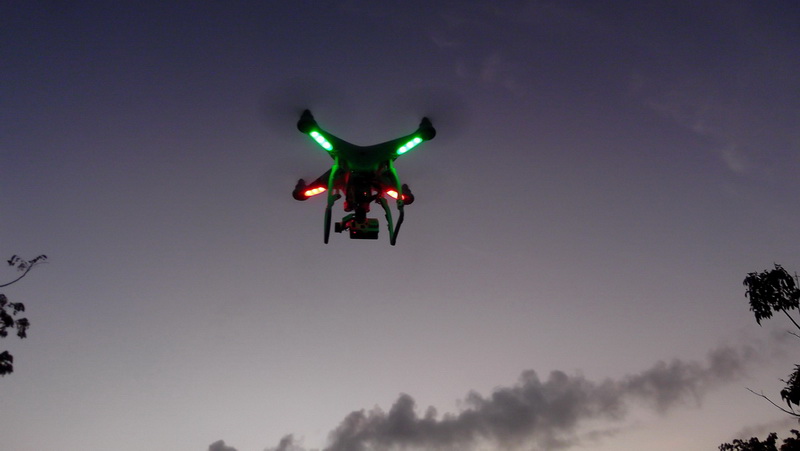 and down continuously through 3 position (ATTI<<>>ATTI<<>>GPS) switch 6 or 7 times until the LED on PHANTOM turns yellow. These procedure is compulsory and standard. But all those frequent flicking around the switches up and down will actually causes then contact under the switch worn out. It happen to me one day when my custom Fail Safe with on 1st down position was not working indicating "0" value inside NAZA assistance software while the ATTI and GPS mode switch works well. So if it happens try to flick up and down harder until the last ATTI value activated as indicated in your software to get the contact plate locked in. Unfortunately you won't notice if the lower ATTI was activated or not unless you have a IOSD mini to show those value in the LCS screen in FPV setup.
and down continuously through 3 position (ATTI<<>>ATTI<<>>GPS) switch 6 or 7 times until the LED on PHANTOM turns yellow. These procedure is compulsory and standard. But all those frequent flicking around the switches up and down will actually causes then contact under the switch worn out. It happen to me one day when my custom Fail Safe with on 1st down position was not working indicating "0" value inside NAZA assistance software while the ATTI and GPS mode switch works well. So if it happens try to flick up and down harder until the last ATTI value activated as indicated in your software to get the contact plate locked in. Unfortunately you won't notice if the lower ATTI was activated or not unless you have a IOSD mini to show those value in the LCS screen in FPV setup. - If started to flyaway..
If you notice the PHANTOM started to drift away or uncommand "run-away" from your control quickly switch to ATTI mode immediately. If you have IOC switch active the turn it off to normal position (non-headless) to regain control.
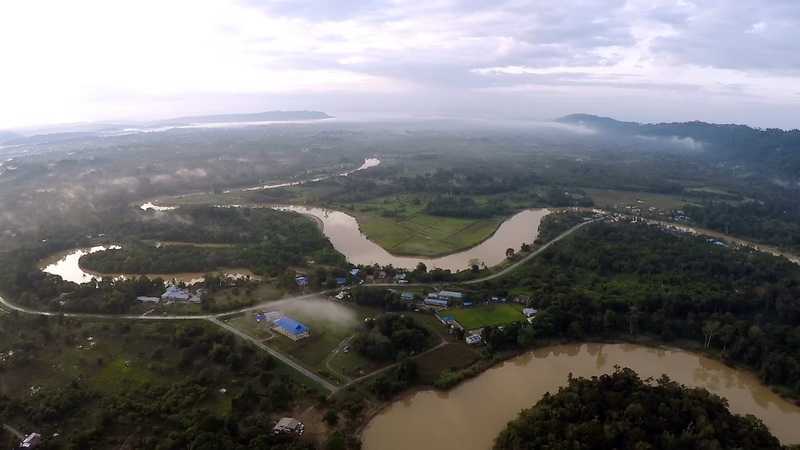
Summary
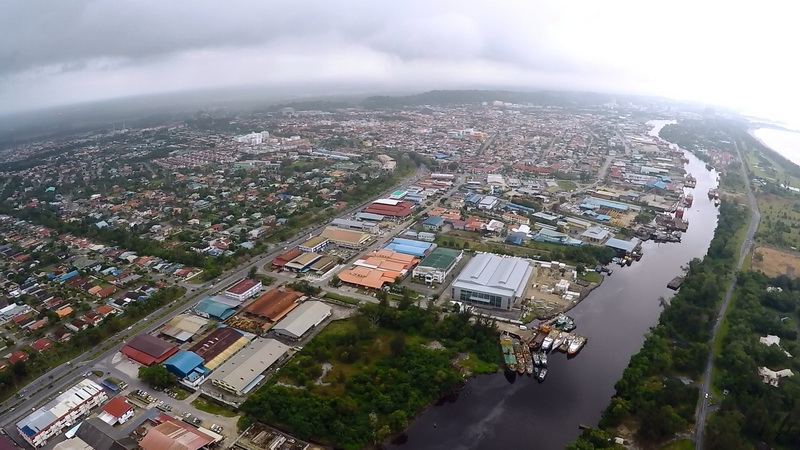 Flying DJI PHANTOM as an FPV platform isn't as fun as i though it would because it was only best to do what it was meant to be built for: aerial video and photography. It does the job extremely well so far due to its extreme stability, minimal vibration and took great steady in the air shot with me fighting the control by external factor such as wind and unstable weather condition. It save me much headache setting up the quadcopter and best of all lots of support both hardware locally and online community based resources. Despite being overall costly on first purchase for the performance and quality it offer no doubt it was worth paying which i could understand that DJI was the only true brand that concentrate more on multi-rotor development and innovation than going outside their original goal unlike other competitors such as WALKERA and other rivalry whose quite jumpy with their product, goal and support. I always stood on common ground with Open source APM flight
Flying DJI PHANTOM as an FPV platform isn't as fun as i though it would because it was only best to do what it was meant to be built for: aerial video and photography. It does the job extremely well so far due to its extreme stability, minimal vibration and took great steady in the air shot with me fighting the control by external factor such as wind and unstable weather condition. It save me much headache setting up the quadcopter and best of all lots of support both hardware locally and online community based resources. Despite being overall costly on first purchase for the performance and quality it offer no doubt it was worth paying which i could understand that DJI was the only true brand that concentrate more on multi-rotor development and innovation than going outside their original goal unlike other competitors such as WALKERA and other rivalry whose quite jumpy with their product, goal and support. I always stood on common ground with Open source APM flight 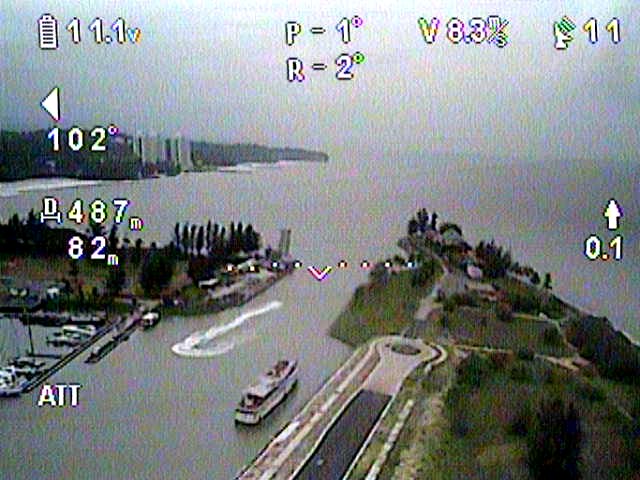 controller but can't denied the precision flying quality of DJI products after witnessing my buddies flying PHANTOM and NAZA based flight controller. Most importantly with the money paid i get the expected result and it does job well done and run for my money.
controller but can't denied the precision flying quality of DJI products after witnessing my buddies flying PHANTOM and NAZA based flight controller. Most importantly with the money paid i get the expected result and it does job well done and run for my money.
I'm very happy with PHANTOM V1.1.1 despite its the cheapest model without unnecessary accessories and its the last version of its kind that uses 2.4ghz radio controller because it has better radio penetration and range, you can also added commercial WIFI booster to boost the range too. However caution with 2.4ghz WIFI capable camera as it will knock off your radio controller. By 2015 the V1 model is rarely available in the market but if it does it always sold as second hand item with great bargaining price. The PHANTOM V2 model by now are abundant in the market offer WIFI connectivity to your phone or tablet and 5.8ghz radio controller frequency to fit well and avoid interference with popular 2.4ghz WIFI HD camera such as GO-PRO, SJCAM, SONY, JVC and other sport camera that fits PHANTOM payload. If you get your first PHANTOM be sure to read manual and always calibrate your compass before any flight at any location else you'll ended up joining a band community of flyaway trauma center.
Videos/Medias![]() Here are some of my aerial photography shots and media related to my DJI PHANTOM V1.1.1 which already converted into FPV:
Here are some of my aerial photography shots and media related to my DJI PHANTOM V1.1.1 which already converted into FPV:
- Full aerial HD photo gallery: DJI PHANTOM V1.1.1 - 350mm
- My Youtube channel: 3DXL
- My videos:
- Flight video: FPV DJI PHANTOM - Forest Run (59~60fps)
- Flight video: FPV DJI PHANTOM - Green morning
- Flight video: FPV DJI PHANTOM - Home town
- Flight video: FPV DJI PHANTOM - Public demo
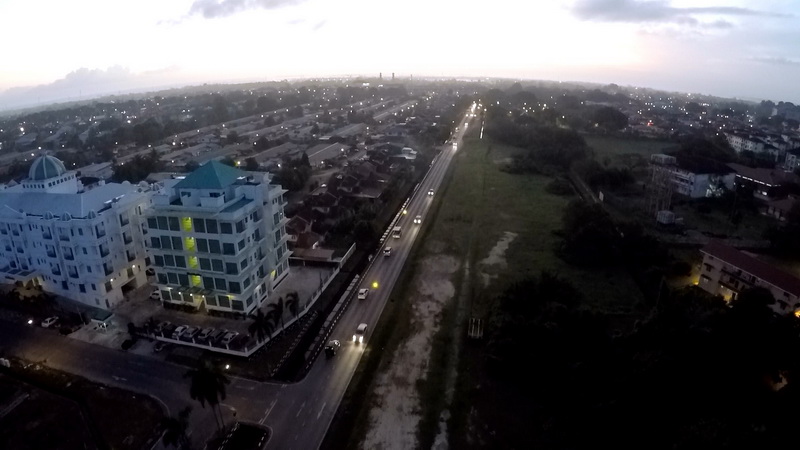
Shopping list
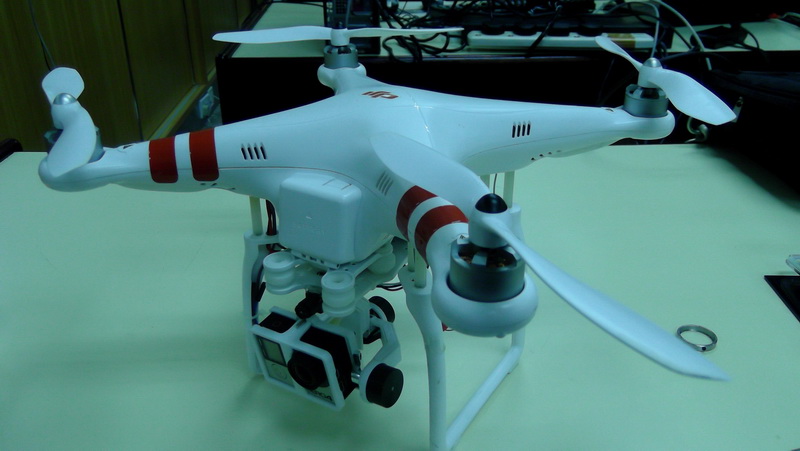 DJI PHANTOM lines of multi-rotors are available widely around the world both at your quality hobby stores and online. Its Plug and Fly (PNF) means that pull it out of the box, read the manual and fly. There not much stuff to upgrade if you fly normally 'Line of Sight' but if you thinking wanted to upgrade for additional extra feature such as FPV capabilities, aerial photography and stuff you see i'm building up there here are some list of hardware and parts which fits nicely with PHANTOM 1/2:
DJI PHANTOM lines of multi-rotors are available widely around the world both at your quality hobby stores and online. Its Plug and Fly (PNF) means that pull it out of the box, read the manual and fly. There not much stuff to upgrade if you fly normally 'Line of Sight' but if you thinking wanted to upgrade for additional extra feature such as FPV capabilities, aerial photography and stuff you see i'm building up there here are some list of hardware and parts which fits nicely with PHANTOM 1/2:
- Camera Gimbal:
- Walkera G-2D Camera Gimbal for iLook iLook+ / Gopro 3 Plastic Version
- FPV 2 Axis Brushless Gimbal With Controller For DJI Phantom GoPro 3
- DJI Zenmuse H3-3D Standard Version 3 Axis Gimbal With GCU
- DJI Phantom Carbon Fiber Anti-vibration 4-Axis FPV Gimbal for Gopro 3
- DJI Phantom Controller Pitching Joystick For DJI Original Controller
- DJI Phantom Camera Mount Gimbal For Gopro 2 Gopro 3
- Refit DJI Phantom 2 Vision FC200 Brushless Gimbal w/Motors&Controller
- Radio set/combo (If you wanted to upgrade radio range/distance):
- FrSKY TARANIS X9D ACCST 2.4ghz transmitter version B
- FrSky DHT 8CH DIY compatible telemetry transmitter module (Advance installation required)
- Frsky V8FR-II 2.4ghz 8ch receiver HV version
- Frsky V8R7-II 2.4ghz 8ch receiver
- DJI PHANTOM Vision Remote Control Extend Range Set Signal Booster
- 2.4g Mini Signal Expansion Device For Dji Phantom Transmitter
- Rechargeable DJI Phantom Remote Control Transmitter Battery
- Motor/ESC/BEC spare parts and upgrades:
- Proppellers:
- Self-locking Propellers White For DJI Phantom Version 1 Version 2
- DJI Phantom 1 8443 Self-locking CF Propeller For 22xx CW/CCW Motor(SB)
- Carbon Fiber 9443 Propeller Self-locking for DJI Phantom 2 Vision
- DJI Phantom 1 2V+ V303 V393 CX-20 Propeller & Protection Cover WSX-003
- DJI Phantom 2 Vision FC40 9443 Camouflage Propeller CW/CCW
- Main FPV piloting camera (For main FPV view):
- SONY EFFIO 1/3 CCD 700TVL aerial camera NTSC (Bulky but excellent high FPS live quality)
- FPV 800TVL mini CMOS NTSC
- 420TVL CCD camera (Best budget FPV camera)
- HORYZON HD full FPV camera (Popular among FPV hardcore use as competitive to Go-Pro)
- Keychain 808 #16 V1 HD camera
- Keychain 808 #16 V3 HD (With live output and HD recording, most popular among r/c and FPV use)
- 1/3 600TVL CMOS NTSC (Best on mini 200 size FPV platform with advantage of generic interchangeable lens)
- 1/3 600TVL CMOS PAL (Best on mini 200 size FPV platform with advantage of generic interchangeable lens)
- FATSHARK 1/3 600TVL CMOS NTSC/PAL (Best on mini 200 size FPV platform with advantage of generic interchangeable lens)
- BOSCAM HD19 Plus Explorer Full 1080p RC Aerial Photography FPV camera
- Mobius 1080p HD (Excellent quality)
- Camera HD for recording (Will fit on any commercial gimbal generically):
- SJcam SJ5000 Plus Ambarella A7LS75 FHD 60FPS Sport Action Camera
- SJCAM SJ5000 WiFi Novatek 96655 Full HD Car Action Sports Camera
- SJcam SJ5000 Novatek 96655 Full HD Car Action Sports Camera
- SJcam SJ4000 WiFi Car DVR Camera Sport DV Novatek Waterproof
- SJcam SJ4000 HD 1.5 Inch Car DVR Camera Sport DV Waterproof Camera
- SJcam WiFi Version SJ4000 GoPro Style Extreme Camera without Accessary
- USB to TV Out Cable for SJ4000 SJ4000 WIFI SJCAM Action Camera
- 3.7V 900mAh Li-ion Battery for All SJcam Cameras SJ4000 SJ5000 M10
- FC40 Camera For DJI Phantom FC40 RC Quadcopter
- Flight controller/AP System/OSD (Optional for FPV flight):
- Video transmitter/LCD monitor/combo:
- FeelWorld FW-718 FPV-718 7 Inch FPV Monitor For DJI Phantom Inspire 1
- BOSCAM 2.4ghz 500mw transmitter + receiver (Better obstacle penetration but recomended your radio controller uses other than 2.4ghz to avoid conflict)
- BOSCAM 5.8ghz 200mw transmiter (Basic)
- BOSCAM 5.8Ghz 400w transmitter
- BOSCAM 5.8ghz 8ch receiver
- BOSCAM 5.8Ghz 400w transmitter + receiver combo
- BOSCAM 5.8ghz 600mw transmitter 32ch (Medium range)
- BOSCAM 5.8ghz 600mw transmitter + receiver combo 32ch (Medium range)
- BOSCAM RC305 8ch wireless Audio/Video receiver (Basic requirement for 5.8ghz)
- BOSCAM 5.8ghz 200mw transmitter + receiver combo pack
- BOSCAM AIO FPV video goggle GS920 with receiver 2.4ghz/5.8ghz (Excellent for serious FPV flyer)
- BOSCAM AIO FPV video goggle GS922 with diversified receiver and built-in DVR
- SKYZONE SKY-01 FPV video goggle with receiver 5.8ghz diversity antenna build-in (Excellent for serious FPV flyer)
- SKYZONE SKY-700D FPV 5.8ghz 32ch monitor + DVR (Excellent for starter and complete DVR combo)
- SKYZONE RC702 SKY-702 5.8ghz 7" AIO diversity receiver monitor
- FPV 7" TFT LCD monitor 800x480 screen with audio (Excellent for budget beginner DIY FPV build)
- FATSHARK Predator V2 FPV video goggle complete combo package (Popular choice but only works with FATSHARK video/audio transmitter compatibles)
- FATSHARK Teleporter V3 FPV video goggle complete combo package HD (Popular choice but only works with FATSHARK video/audio transmitter compatibles)
- FATSHARK DOMINATOR FPV video goggle (Excellent for expert/performance DIY FPV system)
- FATSHARK BASE HD (Popular customizable choice but only works with FATSHARK video/audio transmitter compatibles)
- FPV video goggle Monocular Visual high resolution for aerial photography
- DJI 5.8G 3 Leaves Mushroom Antenna Transmitter For DJI Phantom
- Battery (Fit on PHANTOM V1 only):
- Other accessories:
- Heighten Broaden Landing Gear Skid for DJI Phantom RC Quadcopter
- Waterproof Backpack For QR X350 DJI Phantom 1 Phantom 2 Vision+ FC40
- Waterproof Backpack For DJI Phantom 1 Phantom 2 Vision Vision+ FC40
- DJI Phantom V303 CX-20 Quanum Nova Upgraded Propeller Protective Guard
- DJI PHANTOM RGB Colorful Color Changeable Headlight Headlamp
- Sun Hood Sun Shade for DJI Phantom 2 Vision Vision+ FC40
- FC DJI Phantom 1/2 Vision General Heighten Broaden Landing Gear Skid
- DJI Phantom Timer RC Quadcopter Parts For DJI Original Controller
- 1 To 2 Battery Expansion Cable Wire For DJI Phantom
- ATG DJI Phantom Upgrade Brushless Gimbal Standard Height Landing skid
- ATG Upgrade Carbon Fiber Landing Skid For DJI Phantom
- Heighten Landing Gear Skid for DJI Phantom RC Quadcopter
- Decoration Light Strap 80 LED Lamps For DJI Phantom RC Quadcopter
- DJI PHANTOM v1 and v2 full package
Building threads/Referral/Support forum
If you don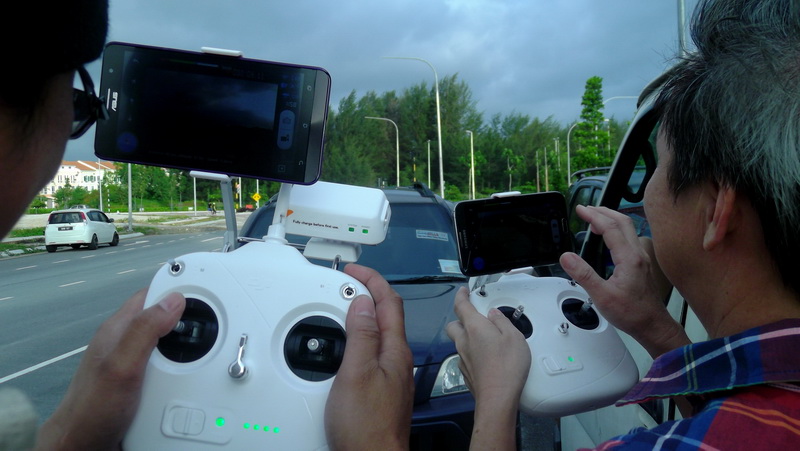 't know where to begin with i recommend you to start reading some guides, wikis and building tips from popular on-line resources as listed below. You might find me hanging around some popular R/C and FPV forum below.
't know where to begin with i recommend you to start reading some guides, wikis and building tips from popular on-line resources as listed below. You might find me hanging around some popular R/C and FPV forum below.
- DJI Forum
- Phantom Pilots
- DJI Guys forum
- Multirotor forum
- Djiphantomforum.net
- Rcgroups FPV forum
- Djiphantom-forum.com
- Facebook: DJI Flyaway & Crash Psychological Support Page
- DJI product website
- DJI Phantom wiki (very usefull)
